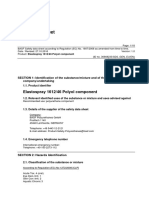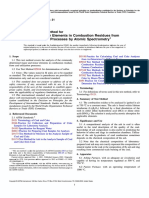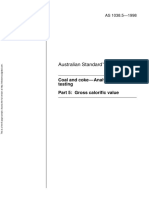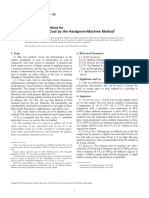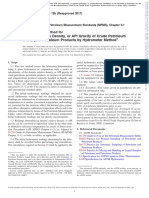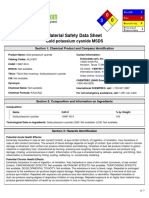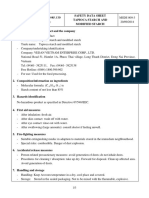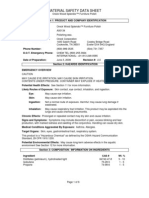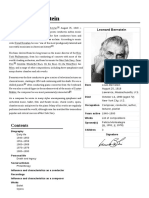Sawdust MSDS
Sawdust MSDS
Uploaded by
Dandika RamdhanCopyright:
Available Formats
Sawdust MSDS
Sawdust MSDS
Uploaded by
Dandika RamdhanCopyright
Available Formats
Share this document
Did you find this document useful?
Is this content inappropriate?
Copyright:
Available Formats
Sawdust MSDS
Sawdust MSDS
Uploaded by
Dandika RamdhanCopyright:
Available Formats
Material Safety Data Sheet
Sawdust
I. PRODUCT AND COMPANY IDENTIFICATION
Product Name: Sawdust Date Revised: 7/2010
Generic Description: Solid particles, dust and chips consisting primarily of kiln dried softwood
Synonyms: Pine Sawdust
Supplier:
NOV FluidControl
4310 N Sam Houston Parkway East
Houston, Texas 77032 USA
Office: (713) 482-0500
Fax: (713) 482-0695
Company website: www.nov.com
Emergency Telephone Number:
CHEMTREC: 1-800-424-9300 or International +1-703-527-3887
II. COMPOSITION
Material or Component Percentage % CAS Number Exposure Limits
(mg/m3)
ACGIH-TWA1 WCB of BC-TWA1 AB OHS OEL2
Wood Dust (Total) 100% N/A 1.0 2.5 (non-allergenic3) 5.0
Softwoods and hardwoods
except western red cedar
ACGIH - American Conference of Governmental Industrial Hygienists, 2007 Threshold Limit Values for Chemical
and Physical Agents
1
TWA - time-weighted average for a normal 8-hour workday and a 40-hour workweek
2
OEL - Alberta Occupational Health and Safety Code 2006 – Schedule 1, Table 2 – Occupational exposure limits
for chemical substances within an 8-hour workday
3
Pine softwoods are NOT considered allergenic as per Chan-Yeung, M, Malo, J-L, "Aetological Agents in
Occupational Asthma," European Respiratory Journal, Volume 7, 1994 (pp. 346-371).
III. FIRST AID MEASURES
Eye Contact:
In case of eye contact, flush with water for at least 15 minutes. Get medical attention if required.
Skin Contact:
Wash thoroughly with soap and water. Get medical attention if required.
Inhalation:
Remove the person from the area. Keep at rest. Call for medical attention if required.
Ingestion:
Seek medical attention if required.
D4A2001166 Rev02 Page 1 of 4
Sawdust Material Safety Data Sheet
IV. FIRE AND EXPLOSION DATA
Fire Hazards: Product contains wood by-products; combustible.
Mixing with perchloric acid may cause product to self-ignite.
Flash Point: N/AP
Firefighting: Water, foam, CO2, or dry chemical. Firefighters must wear appropriate
breathing apparatus and clothing.
Hazardous Combustion Products: Combustion or thermal decomposition may generate oxides of carbon (e.g.,
CO, CO2), oxides of sulphur, and/or hydrogen chloride gas (HCl).
Upper Flammable Limit: N/AP
Lower Flammable Limit: N/AP
V. PREVENTATIVE MEASURES
Engineering Controls: N/AP
Respirator: Use a NIOSH-approved respirator when
Occupational Exposure Limits are exceeded and
engineering controls are not practicable.
Eyewear: Safety goggles are recommended.
Clothing: Wear long sleeves and gloves to avoid skin contact.
Other Handling Precautions:
Minimize stirring/turbulence of dust.
Wash thoroughly after handling.
Do not smoke when handling this product.
Keep away from open flames, sparks, pilot lights,
perchloric acid and other sources of ignition.
Storage Requirements:
Store in a cool, dry place.
Keep away from open flames, sparks, pilot lights,
and other sources of ignition.
Segregate from incompatible materials (see Reactivity Data).
VI. PHYSICAL AND CHEMICAL PROPERTIES
Physical state & Appearance: Light to dark colored granular
solid, finely divided material.
Freezing/Melting Point: N/AP
Evaporation Rate: N/AV
Density: N/AV
Odor: Pine
pH: N/AV
Odor Threshold: N/AV
Solubility: Insoluble in water
Boiling Point: N/AP
Viscosity: N/AV
NOTES:
N/AV = Not Available
N/AP = Not Applicable
D4A2001166 Rev02 Page 2 of 4
Sawdust Material Safety Data Sheet
VII. STABILITY AND REACTIVITY
REACTIVITY DATA
Chemical Stability: Stable
Incompatible Substances & Conditions to Avoid:
Keep away from oxidizers, drying oils and ignition sources; mixing
with perchloric acid may cause product to self-ignite. A severe explosion
hazard may exist if a wood dust cloud comes into contact with a source of
ignition. Partially burned or scorched wood dust is especially hazardous if
dispersed in air because of its explosivity.3
Decomposition Products:
Thermal decomposition may generate oxides of carbon (e.g., CO, CO2),
oxides of sulphur, and/or hydrogen chloride gas (HCl).
Hazardous Polymerization:
Will not occur.
VIII. TOXICOLOGICAL INFORMATION
ROUTES OF ENTRY:
Skin: Yes
Eye: Yes
Inhalation: Yes
Ingestion: Yes
EFFECTS OF ACUTE EXPOSURE:
INHALATION: Airborne treated or untreated wood dust may cause nose, throat or lung irritation. Various species
of untreated wood dust can elicit allergic respiratory response in sensitized persons, hypersensitivity, asthma,
suberosis, granulomatous pneumonitis, or acute airway obstruction. 3
INGESTION: Not anticipated to occur. A single ingestion of a very large dose of wood dust may require immediate
medical attention.
SKIN CONTACT: Skin contact may cause erythema, blistering, erosion and secondary infections of the skin,
redness, scaling, itching, and vesicular dermatitis.3
EYE IRRITATION: May cause redness and irritation of the eye.3
EFFECTS OF CHRONIC EXPOSURE:
Chronic exposure to wood dusts can result in dermatitis reactions, asthma, pneumonitis, and coughing, wheezing,
fever and the other signs and symptoms associated with chronic bronchitis.3
SKIN SENSITIZER: Pinenes that contain delta-caratene are classified as sensitizers. Such substances may
produce an allergic reaction after initial exposure allergic dermatitis typically results in redness, scaling, and
itching, which may become vesicular dermatitis if exposures are repeated. This type of dermatitis often occurs on
the hands, face, forearms, eyelids, neck, and genitals, and will sometimes not appear until several years have
passed following the exposure, although frequently the signs are apparent within a few days or weeks. 4
D4A2001166 Rev02 Page 3 of 4
Sawdust Material Safety Data Sheet
CARCINOGEN: The International Agency for Research on Cancer (IARC) has classified “wood dust” as Group 1,
Carcinogenic to Humans. This is a generic classification for all woods, even though certain individual wood species
may not be carcinogenic. IARC has also indicated that hardwoods may be more hazardous than softwoods.5
1 CIS Chemical Information (ILO/CIS) - Country Exposure Limits. - American Conference of Governmental
Industrial Hygienists. Retrieved from WORLD WIDE WEB on October 9, 2003:
http://www.inchem.org/documents/ilodb/explimit/acgih.htm
2 Chemical and Biological Substances - ITEM: R5.48-, Exposure Limits and Designations, Appendix D. The
Workers’ Compensation Board of British Columbia Resolution of the Board of Directors. Retrieved from the
WORLD WIDE WEB on October 9, 2003:
http://www.worksafebc.com/law_and_policy/policy_decision/board_decisions/2003/july/assets/pdf/oel/resolution_2
003-07-15-01.pdf
3 Occupational Safety and Health Guideline for Wood Dust, All Soft and Hardwoods, Except Western Red Cedar.
Occupational Safety and Health Administration, U.S. Department of Labor. Retrieved from the WORLD WIDE
WEB on October 9, 2003.
http://www.osha.gov/SLTC/healthguidelines/wooddustallsoftandhardwoodsexceptwesternredcedar/recognition.html
4 Hathaway GJ, Proctor NH, Hughes JP, and Fischman ML [1991]. Proctor and Hughes'chemical hazards of the
workplace. 3rd ed. New York, NY: Van Nostrand Reinhold.
5 IARC. International Agency for Research on Cancer. Wood Dust. IARC Monographs on the Evaluation of
Carcinogenic Risk of Chemicals to Humans. Vol. 62. Lyon, France: IARC, 1995, pp. 35-215.
DISCLAIMER:
Although the information and recommendations set forth herein (hereinafter “Information”) are presented
in good faith and believed to be correct as of the date hereof, NOV FluidControl, makes no representations
as to the completeness or accuracy thereof. Information is supplied upon the condition that the person
receiving this MSDS will make own determination as to its suitability for their intended purpose prior to
use. Since the product is within the exclusive control of the user, it is the user’s obligation to determine
the conditions of safe use of this product. Such conditions should comply with all Federal Regulations
concerning the Product. NO REPRESENTATIONS OR WARRANTIES, EITHER EXPRESS OR IMPLIED, OF
MERCHANTABILITY, FITNESS FOR A PARTICULAR PURPOSE OR ANY OTHER NATURE ARE MADE
HERUNDER WITH RESPECT TO INFORMATION OR THE PRODUCT TO WHICH INFORMATION REFERS.
For further information contact:
NOV FluidControl
4310 N Sam Houston Parkway East
Houston, Texas 77032 USA
Office: (713) 482-0500
Fax: (713) 482-0695
Company website: www.nov.com
D4A2001166 Rev02 Page 4 of 4
You might also like
- Certificate of Analysis: Benzoic AcidDocument4 pagesCertificate of Analysis: Benzoic AcidTANIA MARGARITA ANGEL GALINDONo ratings yet
- MSDS Ethanol Indo AcidatamaDocument6 pagesMSDS Ethanol Indo AcidatamadianNo ratings yet
- 980.03 Metales en PlantasDocument2 pages980.03 Metales en Plantaslizeth rico quinteroNo ratings yet
- Pb-65 Soil Sealant Material Safety Data Sheet: ManufacturerDocument6 pagesPb-65 Soil Sealant Material Safety Data Sheet: ManufacturerJaider Coronel RojasNo ratings yet
- MSDS Industrial MargarineDocument3 pagesMSDS Industrial MargarineAeropaulo14No ratings yet
- MSDS Magnet Copper WireDocument3 pagesMSDS Magnet Copper Wireบุญมาชัย มิ่งขวัญNo ratings yet
- SOYA ACID OIL - CertificateDocument1 pageSOYA ACID OIL - CertificateMohammad Abdul MuizNo ratings yet
- Msds For TretinionDocument10 pagesMsds For TretinionYen Ling NgNo ratings yet
- CERTIFICATE OF ANALYSIS PVC FilmDocument4 pagesCERTIFICATE OF ANALYSIS PVC Filmshreeyafasteners100% (1)
- MSDS Natrium BisulfitDocument7 pagesMSDS Natrium BisulfitLusiana OliviaNo ratings yet
- Msds - DRY SOLVEEDocument6 pagesMsds - DRY SOLVEEaudi 2022No ratings yet
- Styrofoam MsdsDocument3 pagesStyrofoam MsdsMark Evan Salutin100% (1)
- Food Color, Blue Powder MSDS: Section 1: Chemical Product and Company IdentificationDocument5 pagesFood Color, Blue Powder MSDS: Section 1: Chemical Product and Company IdentificationAngel LalaNo ratings yet
- LCA On Sulfuric AcidDocument23 pagesLCA On Sulfuric AcidAkliluNo ratings yet
- MSDS 1612 46Document18 pagesMSDS 1612 46sultanprinceNo ratings yet
- D4052-Densimetru Digital PDFDocument4 pagesD4052-Densimetru Digital PDFCorina StanculescuNo ratings yet
- Astm D3682-21Document8 pagesAstm D3682-21bdr85No ratings yet
- As 1038.5-1998 Coal and Coke - Analysis and Testing Gross Calorific ValueDocument7 pagesAs 1038.5-1998 Coal and Coke - Analysis and Testing Gross Calorific ValueSAI Global - APACNo ratings yet
- Coa PeanutDocument1 pageCoa PeanutAli KhanNo ratings yet
- LAPORAN PKL MANAJEMEN PRODUKSDI TEH HITAM CTC (Acc) Aldi FerdiansyahDocument91 pagesLAPORAN PKL MANAJEMEN PRODUKSDI TEH HITAM CTC (Acc) Aldi FerdiansyahAldi FerdiansyahNo ratings yet
- D409 HgiDocument9 pagesD409 HgiArunkumar Chandaran0% (1)
- BS ISO 11722-2013 Inherent MoistureDocument16 pagesBS ISO 11722-2013 Inherent Moisturefatmachemist1No ratings yet
- Din/ Iso Astm RangeDocument2 pagesDin/ Iso Astm RangeSumitBhaumikNo ratings yet
- Msds HexaneDocument7 pagesMsds Hexaneruth indahNo ratings yet
- 21 27 Bulk Density Apparatus PDFDocument2 pages21 27 Bulk Density Apparatus PDFFLed NguyenNo ratings yet
- ASTM D1298 G. Especifica-InglesDocument8 pagesASTM D1298 G. Especifica-InglesEMILIANO100% (1)
- Determine Organic and Inorganic Chlorides in Crude OilDocument2 pagesDetermine Organic and Inorganic Chlorides in Crude OilLim Chee SiangNo ratings yet
- CS-4809C TDSDocument4 pagesCS-4809C TDSlabmatekonsulentteknikaNo ratings yet
- MSDS Calsium OxideDocument6 pagesMSDS Calsium OxidePipit RatnasariNo ratings yet
- Property Unit Test Method Specification Limits Typical Data Astm MIN MAXDocument1 pageProperty Unit Test Method Specification Limits Typical Data Astm MIN MAXDianMulyadiNo ratings yet
- Metals and Related Products Reference Materials Catalogue 2008Document63 pagesMetals and Related Products Reference Materials Catalogue 2008Rachel HillNo ratings yet
- BPS TC Profile - First EditionDocument229 pagesBPS TC Profile - First EditionmartinNo ratings yet
- MSDS GraphiteDocument6 pagesMSDS Graphitepentalight100% (2)
- Magnesium CarbonateDocument7 pagesMagnesium CarbonateAyi Wandhina Asa PratamaNo ratings yet
- BM 2010A X-Ray Fluorescence Multi-Element Measuring Instrument ManualDocument26 pagesBM 2010A X-Ray Fluorescence Multi-Element Measuring Instrument ManualDilnesa EjiguNo ratings yet
- Manufacturers Test Certificate: Printed On 21/06/2023 08:08:36Document1 pageManufacturers Test Certificate: Printed On 21/06/2023 08:08:36BariNo ratings yet
- A.4.b. Naoh Liquid (Cv. Kurnia Jaya) - Coa & MsdsDocument10 pagesA.4.b. Naoh Liquid (Cv. Kurnia Jaya) - Coa & MsdsLailaNo ratings yet
- MSDS - Coconut Shell PowderDocument3 pagesMSDS - Coconut Shell Powder5th07nov3mb2r100% (2)
- Safety Data Sheet Nalco 73310 Corrosion Inhibitor: Section: 1. Product and Company IdentificationDocument10 pagesSafety Data Sheet Nalco 73310 Corrosion Inhibitor: Section: 1. Product and Company IdentificationU.s. Ezhil ArivudainambiNo ratings yet
- Ekspor Fosfat IndonesiaDocument3 pagesEkspor Fosfat IndonesiaKiki AwaliahNo ratings yet
- MSDS CopperDocument6 pagesMSDS Copperpentalight100% (1)
- Material Safety Data Sheet: 1 Identification of SubstanceDocument6 pagesMaterial Safety Data Sheet: 1 Identification of Substancemarjan dronjakNo ratings yet
- TdsDocument2 pagesTdsHRD DSGMNo ratings yet
- Aptekim - Etika Profesi - Process Safety - Wide - 2Document15 pagesAptekim - Etika Profesi - Process Safety - Wide - 2Regita PermatasariNo ratings yet
- Hit Anti Roach Gel MsdsDocument6 pagesHit Anti Roach Gel MsdsNitya UNo ratings yet
- MsdsDocument5 pagesMsdsENRIQUENo ratings yet
- MSDS Recocool HD Premium NDocument3 pagesMSDS Recocool HD Premium NruslanNo ratings yet
- MSDS 009 - enDocument3 pagesMSDS 009 - enindah50% (2)
- MSDS DecisDocument12 pagesMSDS DecisJohn umumNo ratings yet
- GHS Poster - Merck OldDocument1 pageGHS Poster - Merck Oldqwerty uiopNo ratings yet
- Boron Determination in Plant Azomethine HDocument12 pagesBoron Determination in Plant Azomethine HManoleteNo ratings yet
- CAP2 Leave Schedule Eid Al-Fitr 2022 - RTYDocument17 pagesCAP2 Leave Schedule Eid Al-Fitr 2022 - RTYRama Ratya100% (1)
- Safety Data Sheet: Yamalube Ygo 2T Jaso FC SsDocument11 pagesSafety Data Sheet: Yamalube Ygo 2T Jaso FC SsSiong Wu SiewNo ratings yet
- Msds o Xylene PDFDocument6 pagesMsds o Xylene PDFPriska Dewi AnjarsariNo ratings yet
- Certificate of Analysis Gelatin Powder: Test SpecificationDocument1 pageCertificate of Analysis Gelatin Powder: Test SpecificationSerly AlizahNo ratings yet
- Warning: Poly Aluminium Chloride PowderDocument2 pagesWarning: Poly Aluminium Chloride Powderhashemite0% (1)
- CIPETDocument58 pagesCIPETsenthilvelanNo ratings yet
- Material Safety Data SheetDocument5 pagesMaterial Safety Data SheetBudi SantosoNo ratings yet
- Material Safety Data Sheet: Kwik-Seal (All Grades)Document6 pagesMaterial Safety Data Sheet: Kwik-Seal (All Grades)Eliz MelizaNo ratings yet
- A00134-Oreck Wood Splendor Furniture Polish-MSDS-0609-English1Document6 pagesA00134-Oreck Wood Splendor Furniture Polish-MSDS-0609-English1Jv GelvinNo ratings yet
- 3q-Reading and WritingDocument3 pages3q-Reading and WritingClydelle PorrasNo ratings yet
- The European Business Review 05 06 2020 PDFDocument114 pagesThe European Business Review 05 06 2020 PDFGina VarlanNo ratings yet
- Silk Bank Internship ReportDocument33 pagesSilk Bank Internship Reportsohail merchant0% (1)
- Diuretics: Chris Hague, PHDDocument29 pagesDiuretics: Chris Hague, PHDranachamanNo ratings yet
- Sports Practicum (In-Campus)Document5 pagesSports Practicum (In-Campus)Lexis Anne BernabeNo ratings yet
- Hasluck - Margaret Masson HardieDocument9 pagesHasluck - Margaret Masson HardiedevonchildNo ratings yet
- Week 2Document8 pagesWeek 2Bernadette FalcesoNo ratings yet
- СТОП СЛОВА, ЗА КОТОРЫЕ МОГУТ СНЯТЬ МОНЕТИЗАЦИЮDocument41 pagesСТОП СЛОВА, ЗА КОТОРЫЕ МОГУТ СНЯТЬ МОНЕТИЗАЦИЮСавелий СмирновNo ratings yet
- 3rd Model Test EnglishDocument2 pages3rd Model Test Englisharezvi33No ratings yet
- Regis Rogue ReworkDocument3 pagesRegis Rogue Reworkesbenson1826No ratings yet
- Final Theme 4 Unpacked .Learning Competencies - Matatag CurriculumDocument4 pagesFinal Theme 4 Unpacked .Learning Competencies - Matatag Curriculumkatrinamae.agustinNo ratings yet
- Automatic Test Results SD Mean MpsDocument67 pagesAutomatic Test Results SD Mean MpsMaria Cristina Belen ReyesNo ratings yet
- SO2ndEdSUnitTest2Document1 pageSO2ndEdSUnitTest2Rafael Fonseca MartinezNo ratings yet
- DocumentDocument4 pagesDocumentSandy RadjaNo ratings yet
- Letters Home From Vietnam SoldiersDocument2 pagesLetters Home From Vietnam SoldiersCatherine CaoNo ratings yet
- Art Appreciation Likha-Sining For The 21 - Century Filipino StudentsDocument3 pagesArt Appreciation Likha-Sining For The 21 - Century Filipino StudentsJohn Lerry IntiaNo ratings yet
- 0510 m19 QP 42Document12 pages0510 m19 QP 42Akshat VoraNo ratings yet
- Report Writing Format-General FormatDocument5 pagesReport Writing Format-General FormatritikaritikaNo ratings yet
- Proposal WritingDocument2 pagesProposal Writingكمال گاطعNo ratings yet
- Foundations of Organisation StructureDocument29 pagesFoundations of Organisation StructureShashank GowdaNo ratings yet
- Faylis Kurds and Lurs Ambiguity On The FDocument15 pagesFaylis Kurds and Lurs Ambiguity On The FAdam LassNo ratings yet
- Small Scale IndustriesDocument17 pagesSmall Scale IndustriesPradeep Biradar100% (1)
- Essent 1.1 PDFDocument90 pagesEssent 1.1 PDFSpidey ReddyNo ratings yet
- Leonard BernsteinDocument22 pagesLeonard BernsteinBrandon Mcguire50% (2)
- Ode Intimations of ImmortalityDocument5 pagesOde Intimations of ImmortalityPramod Enthralling EnnuiNo ratings yet
- Script Play of Cinderella 2Document6 pagesScript Play of Cinderella 2Joseph Isaac Isaza IIINo ratings yet
- Indo-European - From The Website of Jay Jasanoff - HarvardDocument5 pagesIndo-European - From The Website of Jay Jasanoff - Harvardkrenari68No ratings yet
- 150 WordsDocument29 pages150 WordsDrWaleed Ridha AlJwaidNo ratings yet
- Language Reference: InversionDocument9 pagesLanguage Reference: InversionRNo ratings yet
- A Revised 10-Item Version of The Achievement Motives Scale: Psychometric Properties in German-Speaking SamplesDocument9 pagesA Revised 10-Item Version of The Achievement Motives Scale: Psychometric Properties in German-Speaking SamplesLorea Althea GeniloNo ratings yet














